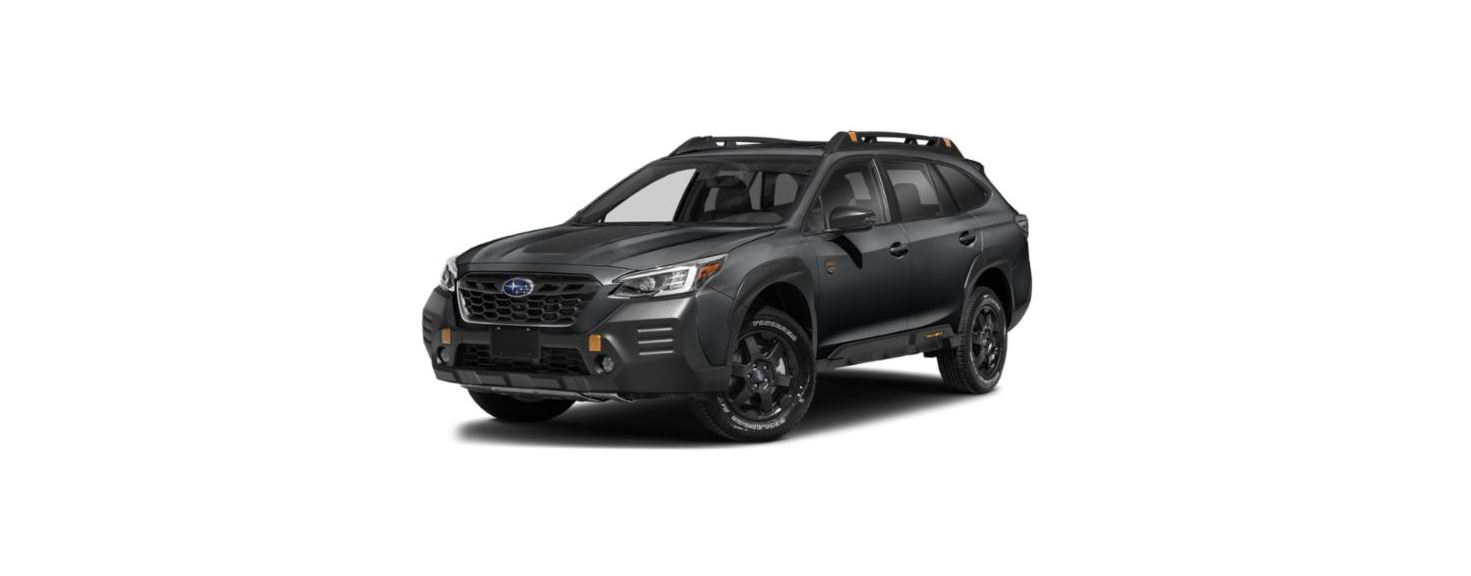2022 Subaru Outback Trailer Towing (Outback/Subaru Outback Wilderness)
Trailer Towing (Outback/Subaru Outback Wilderness)
Your vehicle is designed and intended to be used primarily as a passenger-carrying vehicle. Towing a trailer puts additional loads on your vehicle’s engine, drivetrain, brakes, tires, and suspension and has an adverse effect on fuel economy and air conditioning system cooling performance. If you do decide to tow a trailer, your safety and satisfaction depend upon the proper use of correct equipment and cautious operation of your vehicle. Drive carefully when towing a trailer, and always consider the following conditions.
- Road conditions
- Weather conditions
- Vehicle load weight
- Trailer load weight
Seek the advice of your SUBARU dealer to assist you in purchasing a hitch and other necessary towing equipment appropriate for your vehicle. Do not use towing equipment other than genuine SUBARU towing equipment. In addition, be sure to follow the instructions on the correct installation and use provided by SUBARU.
SUBARU assumes no responsibility for injuries or vehicle damage that result from trailer towing equipment, from any errors or omissions in the instructions accompanying such equipment or for your failure to follow the proper instructions. Regularly check that the hitch mounting bolts and nuts are tightened securely.
Warranties and Maintenance
- SUBARU warranties do not apply to vehicle damage or malfunction caused by trailer towing. If you use your vehicle to tow a trailer, more frequent maintenance will be required due to the additional load. Refer to “Maintenance schedule under severe driving conditions” in the “Warranty and Maintenance Booklet.”
- Under no circumstances should a trailer be towed with a new vehicle or a vehicle with any new powertrain component (engine, transmission, differential, wheel bearings, etc.) for the first 1,000 miles (1,600 km) of driving. After approximately the first 600 miles (1,000 km) of towing all trailer hitch bolts should be re-tightened to the installation torque.
Maximum Load Limits
WARNING
Never exceed the maximum load limits explained in the following. Exceeding the maximum load limits could cause personal injury and/or vehicle damage.
CAUTION
Before towing a trailer, check the trailer’s total weight, GVW, GAWs, and tongue load. Make sure the load and its distribution in your vehicle and trailer are acceptable.
Total trailer weight
The total trailer weight (trailer weight plus its cargo load) must never exceed the maximum total trailer weight. The maximum total trailer weight is indicated in the following tables
2.4 L models
| Conditions | Maximum total trailer weight | Maximum tongue weight |
| When towing a trailer without brakes. | 1,000 lbs (453 kg) | 100 lbs (45 kg) |
| When towing a trailer with brakes. | 3,500 lbs (1,588 kg) | 350 lbs (159 kg) |
2.5 L models
| Conditions | Maximum total trailer weight | Maximum tongue weight |
| When towing a trailer without brakes. | 1,000 lbs (453 kg) | 100 lbs (45 kg) |
| When towing a trailer with brakes. | 2,700 lbs (1,224 kg) | 270 lbs (122 kg) |
Gross Vehicle Weight (GVW) and Gross Vehicle Weight Rating (GVWR)
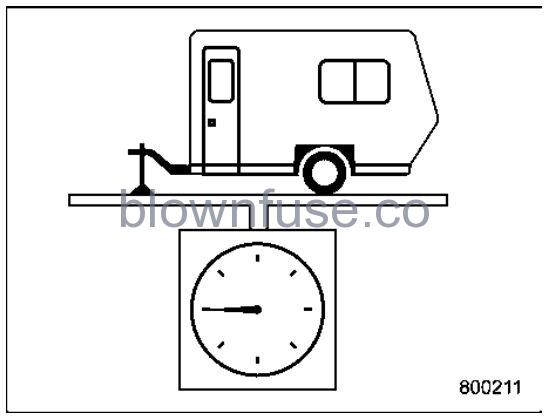
- The Gross Vehicle Weight (GVW) must never exceed the Gross Vehicle Weight Rating (GVWR).
- Gross Vehicle Weight (GVW) is the combined total of the weight of the vehicle, driver, passengers, luggage, a trailer hitch, trailer tongue load and any other optional equipment installed on your vehicle.
- Therefore, the GVW changes depending on the situation. Determine the GVW each time before going on a trip by putting your vehicle and trailer on a vehicle scale.
- The GVWR of your vehicle that is set by SUBARU is shown on the certification label located on the driver’s door of your vehicle
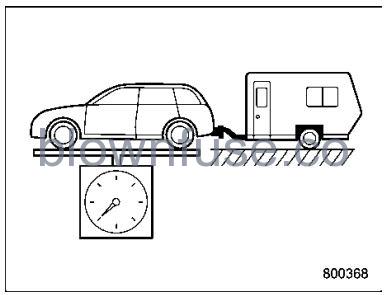
Gross Axle Weight (GAW) and Gross Axle Weight Rating (GAWR)
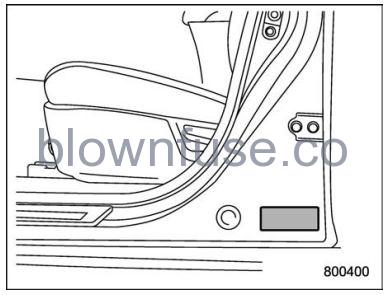
- The total weight applied to each axle (GAW) must never exceed the Gross Axle Weight Rating (GAWR). The front and rear GAWs can be adjusted by relocating passengers and luggage inside the vehicle.
- The front and rear GAWR of your vehicle that is set by SUBARU are also shown on the certification label. To check both GVWR and GAWR and to confirm that the total weight and weight distribution are within safe driving limits, you should have your vehicle and trailer weighed at a commercial weighing station. Be sure that all cargo is firmly secured to prevent a change in weight distribution while driving
Tongue load
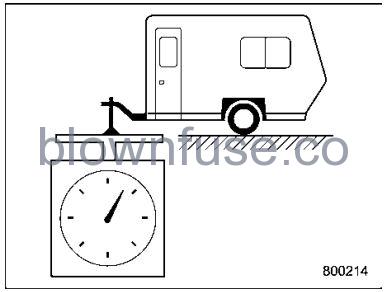
WARNING
If the trailer is loaded with more weight in the back of the trailer’s axle than in the front, the load is taken off the rear axle of the towing vehicle. This may cause the rear wheels to skid, especially during braking or when the vehicle speed is reduced during cornering, resulting in oversteer, spin out, and/or jackknifing.
Ensure that the trailer tongue load is from 8% to 11% of the total trailer weight and does not exceed the maximum value. For details about the trailer tongue load, refer to “Total trailer weight” P450.

- Jack
- Bathroom scale
The tongue load can be weighed with a bathroom scale as shown in the following illustration. When weighing the tongue load, be sure to position the towing coupler at the height at which it would be during actual towing, using a jack as shown.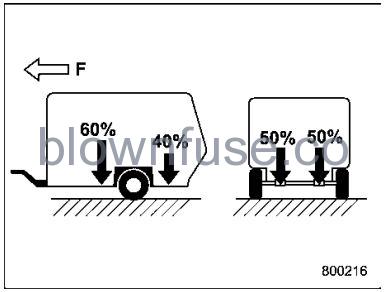
Connecting a Trailer
Trailer brakes
WARNING: Do not directly connect your trailer’s hydraulic brake system to the hydraulic brake system in your vehicle. Direct connection would cause the vehicle’s brake performance to deteriorate and could lead to an accident.
Check that your trailer’s brakes conform with Federal, state/province, and/or other applicable regulations. Your SUBARU’s brake system is not designed to be tapped into the trailer’s hydraulic brake system. Please ask your SUBARU dealer and professional trailer supplier for more information about the trailer’s brake system.
Trailer safety chains
WARNING
Always use safety chains between your vehicle and the trailer. Towing a trailer without safety chains could create a traffic safety hazard if the trailer separates from the hitch due to coupling damage or hitch ball damage
- In case the trailer hitch connector or hitch ball should break or become disconnected, the trailer could get loose and create a traffic safety hazard.
- For safety, always connect the towing vehicle and trailer with trailer safety chains. Two chains should be used in total, one to the right side and the other to the left side trailer tongue. Pass the chains crossing each other under the trailer tongue to prevent the trailer from dropping onto the ground in case the trailer tongue should disconnect from the hitch ball.
- Allow sufficient slack in the chains taking tight turn situations into account; however, be careful not to let them drag on the ground
Side mirrors
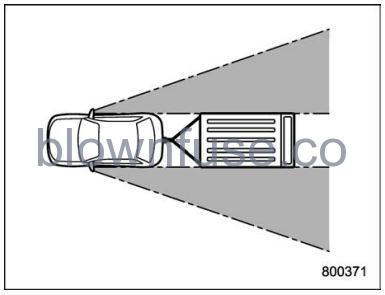
After hitching a trailer to your vehicle, check that the standard side mirrors provide a good rearward field of view without significant blind spots. If significant blind spots occur with the vehicle’s standard side mirrors, use towing mirrors that conform with Federal, state/province and/ or other applicable regulations.
Trailer lights
CAUTION: Direct splicing or other improper connection of trailer lights may damage your vehicle’s electrical system and cause a malfunction of your vehicle’s lighting system
The connection of trailer lights to your vehicle’s electrical system requires modifications to the vehicle’s lighting circuit to increase its capacity and accommodate wiring changes. To ensure the trailer lights are connected properly, please consult your SUBARU dealer. Check for proper operation of the turn signals and the stoplights each time you connect a trailer to your vehicle.
Tires
WARNING
Never tow a trailer when the temporary spare tire is used. The temporary spare tire is not designed to sustain the towing load. Use of the temporary spare tire when towing can result in failure of the spare tire and/or less stability of the vehicle
- Make sure that all the tires on your vehicle are properly inflated. Refer to “Tires” P546.
- Trailer tire condition, size, load rating and proper inflation pressure should be in accordance with the trailer manufacturer’s specifications.
- In the event your vehicle gets a flat tire when towing a trailer, ask a commercial road service representative or professional to repair the flat tire.
- If you carry a regular size spare tire in your vehicle or trailer as a precaution against getting a flat tire, be sure that the spare tire is firmly secured.
Trailer Towing Tips
CAUTION
- For models equipped with the BSD (Blind Spot Detection) and RCTA (Rear Cross Traffic Alert) driving support systems, when towing a trailer, touch “BSD/ RCTA” to deactivate the system. The system may not operate properly due to the blocked radar waves. For details about how to turn on/off the BSD/RCTA, refer to “Car settings” P223.
- For models equipped with Reverse Automatic Braking (RAB) system, consult your SUBARU dealer for additional information about towing a trailer.
- Towing a trailer in high temperatures, or on long or steep grades, may cause the vehicle to overheat. Refer to “Engine Overheating” P470.
- When towing a trailer, steering, stability, stopping distance and braking performance will be different when compared to normal operation. You should never drive at excessive speeds but always employ extra caution when towing a trailer. You should also keep the following tips in mind.
- When parking on a steep slope with a trailer attached to your vehicle, the braking power of the electronic parking brake may not be sufficient since strong braking power is needed
Before starting out on a trip
- Check the towing regulations for trailer or caravan vehicles that vary by state/region. Failure to comply with the procedures set forth will not only compromise your safety but will also negate your insurance coverage and/or may violate the state road and traffic acts and regulations. . Check that the vehicle and vehicle-to hitch mounting are in good condition. If any problems are apparent, do not tow the trailer.
- Check that the vehicle rests horizontally with the trailer attached. If the vehicle is tipped sharply up at the front and down at the rear, check the total trailer weight, GVW, GAWs, and tongue load again, then confirm that the load and its distribution are acceptable.
- Check that the tire pressures are correct.
- Check that the vehicle and trailer are connected properly. Confirm that
- The trailer tongue is connected properly to the hitch ball.
- The trailer lights connector is connected properly and trailer’s stoplights illuminate when the vehicle’s brake pedal is pressed, and the trailer’s turn signal lights flash when the vehicle’s turn signal lever is operated.
- The safety chains are connected properly.
- All cargo in the trailer is secured safely in position.
- The side mirrors provide a good rearward field of view without a significant blind spot.
- Sufficient time should be taken to learn the “feel” of the vehicle/trailer combination before starting out on a trip. In an area free of traffic, practice turning, stopping, and backing up.
- When using the 2.4 L turbo engine model to tow a trailer, SUBARU recommends using unleaded gasoline with an octane rating of 91 AKI (95 RON) or higher to reduce the risk of engine overheating.
Driving with a trailer
- You should allow for considerably more stopping distance when towing a trailer.
- Avoid sudden braking because it may result in skidding or jackknifing and loss of control.
- Avoid abrupt starts and sudden accelerations.
- Avoid uneven steering, sharp turns, and rapid lane changes.
- Slow down before turning. Make a larger than normal turning radius because the trailer wheels will be closer than the vehicle wheels to the inside of the turn. In a tight turn, the trailer could hit your vehicle.
- Crosswinds will adversely affect the handling of your vehicle and trailer, causing sway. Crosswinds can be due to weather conditions or the passing of large trucks or buses. If swaying occurs, firmly grip the steering wheel and promptly begin decelerating your vehicle at a gradual pace.
- When passing other vehicles, considerable distance is required because of the added weight and length caused by attaching the trailer to your vehicle.
- Reversing the vehicle with a trailer can be difficult and requires experience. Never accelerate or steer rapidly, and grip the bottom of the steering wheel with one hand.
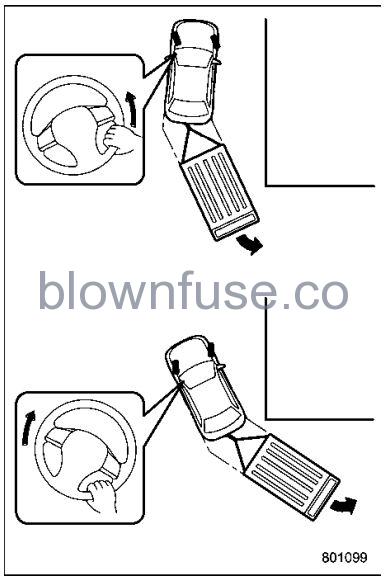
- To reverse around a corner, perform the following procedure.
- Reverse slowly and steer in the opposite direction to the way you want to turn.
- Once the trailer begins to swing around, straighten the steering wheel.
- Turn the wheel in the opposite direction.
- Steer the vehicle around to be in line with the trailer, then straighten the steering again.
- If the ABS warning light illuminates while the vehicle is in motion, stop towing the trailer and have repairs performed immediately by your nearest SUBARU dealer.
Driving on grades
- Before going down a steep hill, slow down and shift into a lower gear (if necessary, use 1st gear) in order to utilize the engine braking effect and prevent overheating of your vehicle’s brakes. Do not make sudden downshifts.
- When driving uphill in hot weather, the air conditioner may turn off automatically to protect the engine from overheating.
- When driving uphill in hot weather, because the engine and transmission are relatively prone to overheating, pay attention to the following items.
- Engine coolant temperature gauge
- AT OIL TEMP warning light
- If any of the following conditions occur, immediately turn off the air conditioner and stop the vehicle in the nearest safe location. Refer to “If You Park Your Vehicle in an Emergency” P458 and “Engine Overheating” P470.
- Do not use the accelerator pedal to stay stationary on an uphill slope instead of using the parking brake or foot brake. That may cause the transmission fluid to overheat.
Parking on a grade
Always block the wheels under both vehicle and trailer when parking. Apply the parking brake. You should not park on a hill or slope. If parking on a hill or slope cannot be avoided, you should take the following steps:
- Apply the brakes and hold the pedal down.
- Have someone place wheel blocks under both the vehicle and trailer wheels.
- When the wheel blocks are in place, release the regular brakes slowly until the blocks absorb the load.
- Apply the regular brakes and then apply the parking brake; slowly release the regular brakes.
- Shift into “P” and shut off the engine.
